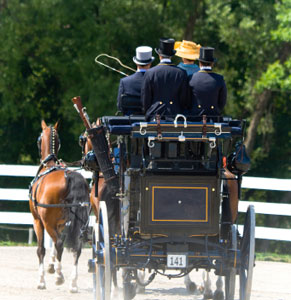
1850's - The Wealthy Come by Stage Coach
In 1828 a road following the French Broad River was completed to Tennessee, which brought wagons and herds moving through town. The Asheville and Greenville Plank Road was built in 1851, and the wealthy aboard four and six horse stages began to come to Asheville as a health resort.
During the Civil War, out of the ten companies of North Carolina Regiment seven of them were Buncombe county men. The Buncombe Rifles marched forth on April 18, 1861 with a flag made of silk dresses of the ladies of the town. Captain Zebulon Vance organized the Rough and Ready Guards. Enfield Rifles, the gun manufacturer, was a flourishing industry here in town.
Around this time, Frances Tiernan of Salisbury published a book in which he described Asheville as “The Land of the Sky” this quickly caught on and has long stayed. The railroad came through in 1880 and brought a new era of expansion to Asheville.
The Battery Park Hotel was built in 1889 atop a grand hill at the top of town. The hotel was one of the nicest in the country and brought many wealthy visitors to Asheville. George W. Vanderbilt stood on the balcony of the hotel and gazed over land and described it as the most beautiful spot in the world. He purchased it and built the epic Biltmore House on 145,000 acres of land. Vanderbilt’s mission to replicate the great estates of Europe brought an elegance to Asheville. Vanderbilt invited friends from the world over to experience Olmsted’s gardens and his 225 room French Renaissance chateau with its own indoor pool and bowling alley.
Lavish hotels such as the Langren Hotel, the Kenilworth Inn and the still famous Grove Park Inn were soon constructed. Shops were springing up all over town, as Asheville became the hub of Western Carolina.
New housing developments such as the Grovemont, Kennilwoth, Malvern Hills and Beverly Hills were a part of the booming expansion. With hope and enthusiasm Asheville was leaping into giant investments when the Stock Market crashed in 1929.
Explore part 3, for a look at Asheville’s Evolution following the stock market crash of 1929.

